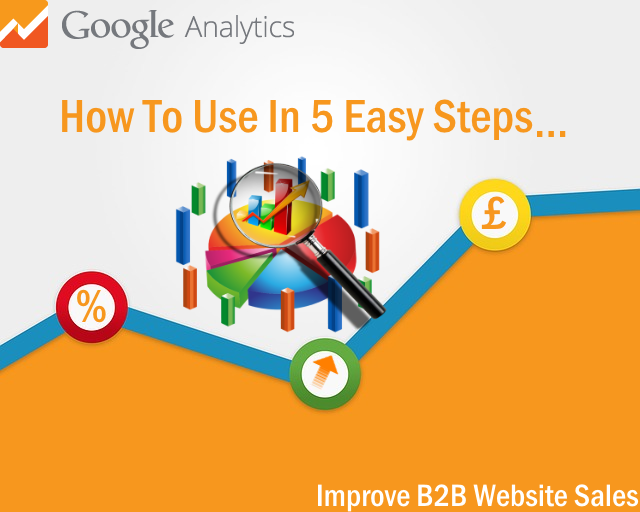How To Use Google Analytics in 5 Easy Steps to Improve B2B Website Sales
 Google Analytics is an invaluable tool which can help you to assess and improve your website's performance. For those running a B2B business, the sales process may often be longer than a company selling to consumers, which means tracking a prospects' activity on your site could improve your website sales and boost conversions. It can be a bit complicated when you're new to Google Analytics though, and it's all too easy to get bogged down with complex reports and data that aren't really relevant to boosting your sales. We're here to show you how to use Google Analytics, with five tips to help you improve your B2B website sales.
Google Analytics is an invaluable tool which can help you to assess and improve your website's performance. For those running a B2B business, the sales process may often be longer than a company selling to consumers, which means tracking a prospects' activity on your site could improve your website sales and boost conversions. It can be a bit complicated when you're new to Google Analytics though, and it's all too easy to get bogged down with complex reports and data that aren't really relevant to boosting your sales. We're here to show you how to use Google Analytics, with five tips to help you improve your B2B website sales.
1. Keep an eye on your exit pages
What are we talking about? Exit pages are where users leave your website, and could be indicative of a problem. For example, if users drop off on your newsletter sign-up page, this may not be the best place for a call-to-action. Or perhaps it's the home page that is seeing the highest rate of exits? Consider if you're bombarding users with too much information – this can be daunting. Your website should be clearly laid out, easy to navigate and informative – beware of information overload. High exit rates could even indicate a technical problem, such as video content on your mobile site that doesn't play on some devices or slow-loading pages. Tracking this information can help you to make improvements which will boost your sales.
2. Track your social media information
Google Analytics provides social media tracking which can help you to see which pages and content on your website are shared the most. This can provide an insight into what's working on your site (and what isn't) and what your customers really care about. Perhaps there's a specific type of blog post which is shared the most frequently, or maybe users love your special offer. Monitoring this information can help you to add more of what visitors love, to your site and eliminate those elements which aren't working so well for you. Make Social Media easier with this great article - 5 Tips To Making Social Media Marketing Easy!
3. Monitor conversion rate and revenue
Monitoring your conversion rate and revenue is crucial to the success of both B2C and B2B companies. Your conversion rate shows you what percentage of visitors become customers (make a purchase) and monitoring this can help you to see which of your marketing strategies is performing the best. A low conversion rate could indicate that a landing page or advert isn't working well for your business – or it could mean that your PPC ads are targeting the wrong people. If your ads aren't being seen by the right people, your conversion rate will drop, yet your campaign will cost you more, reducing your ROI. This is why it's absolutely crucial to stay on top of your conversion rate and take steps to improve it where possible.
4. Track search queries and keywords
Do you know what users are typing in to view your ads or land on your website? No? Well, isn't it about time you found out? Google Analytics can help you to track revenue per keyword and see how many sales each keyword is driving. This way you'll be able to assess what your most profitable keywords are and incorporate them in your PPC ad campaigns and website content more often, driving more traffic to your site and ultimately boosting your website sales! Learn more about choosing keywords here - How To Choose the Right Keywords For SEO.
5. Percentage of new visits
This is a good way to figure out if your website is generating a buzz on social media, and if your ads are performing well. This metric shows you the percentage of new visitors to your website, which can indicate a lot of interest in your business (or a little). If you notice a high percentage of new visitors on your landing page, then including a call-to-action, such as asking them to sign up for an email newsletter or subscribe to your blog, can help to engage these visitors and turn them into customers who will ultimately make a purchase in the future.
There are so many more metrics you can track with Google Analytics to boost your B2B website sales, and you'll find tutorials and instructional videos online to help you do almost anything with Google Analytics. We hope this has given you inspiration and creative ideas for using this tool to improve your website sales.

